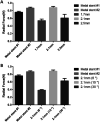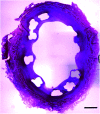Development of a radiopaque, long-term drug eluting bioresorbable stent for the femoral-iliac artery
- PMID: 35529974
- PMCID: PMC9073948
- DOI: 10.1039/c9ra06179g
Development of a radiopaque, long-term drug eluting bioresorbable stent for the femoral-iliac artery
Abstract
Tubular tissues exist in various forms purported for blood supply, waste secretion, etc. to aid proper function and maintenance of the human body. Under pathological conditions, however, these tissues may undergo stenosis. A major surgical treatment for stenosis is to implant a medical device called a stent which aims to expand the narrowed tissue and maintain its patency. Most stents are currently made from metals; despite their high mechanical strength, however, interactions with the host tissue often results in restenosis and stent fracture. To solve these problems, a bioresorbable stent (BRS) is proposed as a next generation stent. In this study, a rotating rod combined 3D printing system was developed to fabricate various types of BRSs. In addition, we confirmed that a 1.5 year long-term release of paclitaxel is possible using polymeric materials. Moreover, a stent loaded with contrast powder was fabricated and was successfully viewed under fluoroscopy. The stent was then implanted in the iliac arteries of pigs and no adverse events were observed for up to 8 weeks.
This journal is © The Royal Society of Chemistry.
Conflict of interest statement
There are no conflicts to declare.
Figures







Similar articles
-
Stenting for peripheral artery disease of the lower extremities: an evidence-based analysis.Ont Health Technol Assess Ser. 2010;10(18):1-88. Epub 2010 Sep 1. Ont Health Technol Assess Ser. 2010. PMID: 23074395 Free PMC article.
-
3D-Printed Radiopaque Bioresorbable Stents to Improve Device Visualization.Adv Healthc Mater. 2022 Dec;11(23):e2201955. doi: 10.1002/adhm.202201955. Epub 2022 Oct 17. Adv Healthc Mater. 2022. PMID: 36168854 Free PMC article.
-
Bioresorbable Scaffolds for Below-the-Knee Arterial Disease: A Literature Review of New Developments.Rev Cardiovasc Med. 2024 Apr 3;25(4):133. doi: 10.31083/j.rcm2504133. eCollection 2024 Apr. Rev Cardiovasc Med. 2024. PMID: 39076564 Free PMC article. Review.
-
Advances in the development of biodegradable coronary stents: A translational perspective.Mater Today Bio. 2022 Jul 19;16:100368. doi: 10.1016/j.mtbio.2022.100368. eCollection 2022 Dec. Mater Today Bio. 2022. PMID: 35937578 Free PMC article. Review.
-
A randomized multicenter comparison of hybrid sirolimus-eluting stents with bioresorbable polymer versus everolimus-eluting stents with durable polymer in total coronary occlusion: rationale and design of the Primary Stenting of Occluded Native Coronary Arteries IV study.Trials. 2012 Dec 15;13:240. doi: 10.1186/1745-6215-13-240. Trials. 2012. PMID: 23241457 Free PMC article. Clinical Trial.
Cited by
-
Feasibility and safety of a novel 3D-printed biodegradable biliary stent in an in vivo porcine model: a preliminary study.Sci Rep. 2022 Sep 23;12(1):15875. doi: 10.1038/s41598-022-19317-y. Sci Rep. 2022. PMID: 36151222 Free PMC article.
-
Novel Self-expanding Shape-Memory Bioresorbable Peripheral Stent Displays Efficient Delivery, Accelerated Resorption, and Low Luminal Loss in a Porcine Model.J Endovasc Ther. 2023 Feb;30(1):140-147. doi: 10.1177/15266028221077001. Epub 2022 Feb 10. J Endovasc Ther. 2023. PMID: 35142226 Free PMC article.
-
3D bioprinting of a trachea-mimetic cellular construct of a clinically relevant size.Biomaterials. 2021 Dec;279:121246. doi: 10.1016/j.biomaterials.2021.121246. Epub 2021 Nov 10. Biomaterials. 2021. PMID: 34775331 Free PMC article.
-
Radiopacity Enhancements in Polymeric Implant Biomaterials: A Comprehensive Literature Review.ACS Biomater Sci Eng. 2024 Mar 11;10(3):1323-1334. doi: 10.1021/acsbiomaterials.3c01667. Epub 2024 Feb 8. ACS Biomater Sci Eng. 2024. PMID: 38330191 Free PMC article. Review.
References
-
- Xue B. Liang B. Wang S. Zhu L. Lu Z. Xu Z. J. Cardiovasc. Surg. 2015;30:97–103. - PubMed
LinkOut - more resources
Full Text Sources

